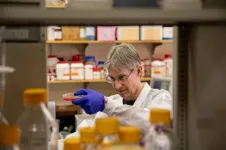(Press-News.org) Babies playfully tease others as young as eight months of age. Since language is not required for this behavior, similar kinds of playful teasing might be present in non-human animals. Now cognitive biologists and primatologists from the University of California Los Angeles (UCLA, US), the Max Planck Institute of Animal Behavior (MPI-AB, Germany), Indiana University (IU, US), and the University of California San Diego (UCSD, US) have documented playful teasing in four species of great apes. Like joking behavior in humans, ape teasing is provocative, persistent, and includes elements of surprise and play. Because all four great ape species used playful teasing, it is likely that the prerequisites for humor evolved in the human lineage at least 13 million years ago.
Joking is an important part of human interaction that draws on social intelligence, an ability to anticipate future actions, and an ability to recognize and appreciate the violation of others’ expectations. Teasing has much in common with joking, and playful teasing may be seen as a cognitive precursor to joking. The first forms of playful teasing in humans emerge even before babies say their first words, as early as eight months of age. The earliest forms of teasing are repetitive provocations often involving surprise. Infants tease their parents by playfully offering and withdrawing objects, violating social rules (so-called provocative non-compliance), and disrupting others’ activities.
In a study recently published in the Proceedings of the Royal Society B, scientists from the University of California Los Angeles, the Max Planck Institute of Animal Behavior, Indiana University, and the University of California San Diego (Isabelle Laumer, Sasha Winkler, Federico Rossano, and Erica Cartmill) report evidence of playful teasing in the four great ape species: orangutans, chimpanzees, bonobos and gorillas. “Great apes are excellent candidates for playful teasing, as they are closely related to us, engage in social play, show laughter and display relatively sophisticated understandings of others’ expectations,” says Isabelle Laumer (UCLA/MPI-AB) a post-doctoral researcher and the first author of the study.
The team analyzed spontaneous social interactions that appeared to be playful, mildly harassing, or provocative. During these interactions, the researchers observed the teaser’s actions, bodily movements, facial expressions, and how the targets of the teasing responded in turn. They also assessed the teaser’s intentionality by looking for evidence that the behavior was directed at a specific target, that it persisted or intensified, and that teasers waited for a response from the target.
The researchers found that orangutans, chimpanzees, bonobos and gorillas all engaged in intentionally provocative behavior, frequently accompanied by characteristics of play. They identified 18 distinct teasing behaviors. Many of these behaviors appeared to be used to provoke a response, or at least to attract the target’s attention. “It was common for teasers to repeatedly wave or swing a body part or object in the middle of the target’s field of vision, hit or poke them, stare closely at their face, disrupt their movements, pull on their hair or perform other behaviors that were extremely difficult for the target to ignore,” explains UCLA and IU professor Erica Cartmill, senior author of the study.
Although playful teasing took many forms, the authors note that it differed from play in several ways. “Playful teasing in great apes is one-sided, very much coming from the teaser often throughout the entire interaction and rarely reciprocated,” explains Cartmill. “The animals also rarely use play signals like the primate ‘playface’, which is similar to what we would call a smile, or ‘hold’ gestures that signal their intent to play.”
Playful teasing mainly occurred when apes were relaxed, and shared similarities with behaviors in humans. “Similar to teasing in children, ape playful teasing involves one-sided provocation, response waiting in which the teaser looks towards the target’s face directly after a teasing action, repetition, and elements of surprise,” Laumer explains.
The researchers noted that Jane Goodall and other field primatologists had mentioned similar behaviors happening in chimpanzees many years ago, but this new study was the first to systematically study playful teasing. “From an evolutionary perspective, the presence of playful teasing in all four great apes and its similarities to playful teasing and joking in human infants suggests that playful teasing and its cognitive prerequisites may have been present in our last common ancestor, at least 13 million years ago,” explains Laumer. “We hope that our study will inspire other researchers to study playful teasing in more species in order to better understand the evolution of this multi-faceted behavior. We also hope that this study raises awareness of the similarities we share with our closest relatives and the importance of protecting these endangered animals.”
END
Do apes have humor?
Study shows that great apes playfully tease each other
2024-02-14
ELSE PRESS RELEASES FROM THIS DATE:
New digital therapy reduces anxiety and depression in people living with long-term physical health conditions
2024-02-14
A therapist-guided digital cognitive behavioural therapy reduced distress in 89 per cent of participants living with long-term physical health conditions, a new King’s College London study finds.
Researchers at the Institute of Psychiatry, Psychology & Neuroscience (IoPPN) at King’s College London found that people living with long-term conditions who received the therapist-guided digital programme called COMPASS showed a significant reduction in psychological distress (a combined score of anxiety and depression) 12-weeks after starting the study.
194 patients were recruited via long-term condition charities, including Crohn’s & ...
Researchers edge closer to delivering personalized medicine to cancer patients
2024-02-14
For the first time, Purdue researchers prove that measuring mechanical motions in living cancer tissues is a viable and promising approach for predicting chemoresistance
Chemotherapy can save lives, but often a cancer patient may be resistant to their prescribed chemotherapy, which costs the patient valuable time. Chemoresistance is a topic that researchers need to understand better so that they can match the right type of chemo to the right patient, which is called personalized medicine.
An unusual pairing of veterinary scientists and physicists believe ...
Trail cameras track ‘critically low’ New York bobcat population
2024-02-13
CORNELL UNIVERSITY MEDIA RELATIONS OFFICE
FOR RELEASE: Feb. 13, 2024
Kaitlyn Serrao
607-882-1140
kms465@cornell.edu
Trail cameras track ‘critically low’ New York bobcat population
ITHACA, N.Y. – With thousands of strategically placed cameras covering more than 27,000 square miles in central and western New York, biologists have evidence that bobcat populations remain critically low in central and western New York state.
Despite reports of recent recoveries elsewhere, bobcat populations in New York State displayed low occupancy, ...
Virginia Tech researchers discover that blocking an essential nutrient inhibits malaria parasite growth
2024-02-13
Living organisms often create what is needed for life from scratch.
For humans, this process means the creation of most essential compounds needed to survive. But not every living thing has this capability, such as the parasite that causes malaria, which affected an estimated 249 million people in 2022.
Virginia Tech researchers in the College of Agriculture and Life Sciences found that by preventing the malaria parasite from scavenging fatty acids, a type of required nutrient, it could no longer grow.
“The key to this breakthrough is that we were able to develop a screening method for the malaria ...
Children's Hospital Los Angeles researchers uncover social and economic factors that influence acute liver failure in children—and ways to overcome them
2024-02-13
Imagine your healthy child gets sick—so sick that you take them to the emergency department. You are shocked to find out that their liver is failing, and they will need a transplant to survive. Studies show that their chances of survival are higher the faster they can get to a hospital that performs liver transplants. But what factors affect how quickly that happens?
Pediatric acute liver failure, also called PALF, is a life-threatening condition that emerges with very little warning in previously healthy children. It is rare, affecting about 5,000 children in the United States a year, and can result from viral ...
Uncovering insights about prostate cancer risk and genetic ancestry
2024-02-13
This study included larger groups of people from African, Hispanic and Asian ancestries than many other previous studies.
A recent study involving scientists from the U.S. Department of Energy’s (DOE) Argonne National Laboratory has uncovered insights into the prostate cancer risks of people from a variety of genetic ancestries. The project, which was led by the University of Southern California, included large increases in representation among men of African, Hispanic and Asian ancestries, that were contributed in part by an ongoing collaboration between the U.S. Department of Veterans Affairs (VA) and DOE as ...
A century of reforestation helped keep the eastern US cool
2024-02-13
American Geophysical Union
13 February 2024
AGU Release No. 24-5
For Immediate Release
This press release and accompanying multimedia are available online at: https://news.agu.org/press-release/a-century-of-reforestation-helped-keep-the-eastern-us-cool/
A century of reforestation helped keep the eastern US cool
Much of the U.S. warmed during the 20th century, but the eastern part of the country remained mysteriously cool. The recovery of forests could explain why
AGU press contact:
Liza Lester, +1 (202) 777-7494, news@agu.org (UTC-5 hours)
Contact information for the researchers:
Kim ...
IL-17 promotes IL-18 production in osteoarthritis synovial fibroblasts via…
2024-02-13
“This study provides novel insights into the pathogenesis of OA and suggests a potential therapeutic target in OA treatment.”
BUFFALO, NY- February 13, 2024 – A new research paper was published in Aging (listed by MEDLINE/PubMed as "Aging (Albany NY)" and "Aging-US" by Web of Science) Volume 16, Issue 2, entitled, “IL-17 promotes IL-18 production via the MEK/ERK/miR-4492 axis in osteoarthritis synovial fibroblasts.”
The concept of osteoarthritis (OA) as a low-grade inflammatory ...
New data speed record on optical fiber
2024-02-13
As data traffic continues to increase, there is a critical need for miniaturized optical transmitters and receivers that operate with high-order multi-level modulation formats and faster data transmission rates. In an important step toward fulfilling this requirement, researchers developed a new compact indium phosphide (InP)-based coherent driver modulator (CDM) and showed that it can achieve a record high baud rate and transmission capacity per wavelength compared to other CDMs. CDMs are optical transmitters used in optical communication systems that can put information on light by modulating the amplitude and phase before it is transmitted through optical fiber.
“Services that require ...
UBCO researchers get to the bottom of non-invasive gut tests
2024-02-13
New research from UBC Okanagan could make monitoring gut health easier and less painful by tapping into a common—yet often overlooked—source of information: the mucus in our digestive system that eventually becomes part of fecal matter.
Correct, what’s in our poop.
Researcher Dr. Kirk Bergstrom and post-graduate student Noah Fancy of UBCO's Biology department discovered a non-invasive technique to study MUC2, a critical gut protein, from what we leave behind in the bathroom.
“MUC2 is like the silent star in our guts. It’s constantly working ...
LAST 30 PRESS RELEASES:
Why nail-biting, procrastination and other self-sabotaging behaviors are rooted in survival instincts
Regional variations in mechanical properties of porcine leptomeninges
Artificial empathy in therapy and healthcare: advancements in interpersonal interaction technologies
Why some brains switch gears more efficiently than others
UVA’s Jundong Li wins ICDM’S 2025 Tao Li Award for data mining, machine learning
UVA’s low-power, high-performance computer power player Mircea Stan earns National Academy of Inventors fellowship
Not playing by the rules: USU researcher explores filamentous algae dynamics in rivers
Do our body clocks influence our risk of dementia?
Anthropologists offer new evidence of bipedalism in long-debated fossil discovery
Safer receipt paper from wood
Dosage-sensitive genes suggest no whole-genome duplications in ancestral angiosperm
First ancient human herpesvirus genomes document their deep history with humans
Why Some Bacteria Survive Antibiotics and How to Stop Them - New study reveals that bacteria can survive antibiotic treatment through two fundamentally different “shutdown modes”
UCLA study links scar healing to dangerous placenta condition
CHANGE-seq-BE finds off-target changes in the genome from base editors
The Journal of Nuclear Medicine Ahead-of-Print Tip Sheet: January 2, 2026
Delayed or absent first dose of measles, mumps, and rubella vaccination
Trends in US preterm birth rates by household income and race and ethnicity
Study identifies potential biomarker linked to progression and brain inflammation in multiple sclerosis
Many mothers in Norway do not show up for postnatal check-ups
Researchers want to find out why quick clay is so unstable
Superradiant spins show teamwork at the quantum scale
Cleveland Clinic Research links tumor bacteria to immunotherapy resistance in head and neck cancer
First Editorial of 2026: Resisting AI slop
Joint ground- and space-based observations reveal Saturn-mass rogue planet
Inheritable genetic variant offers protection against blood cancer risk and progression
Pigs settled Pacific islands alongside early human voyagers
A Coral reef’s daily pulse reshapes microbes in surrounding waters
EAST Tokamak experiments exceed plasma density limit, offering new approach to fusion ignition
Groundbreaking discovery reveals Africa’s oldest cremation pyre and complex ritual practices
[Press-News.org] Do apes have humor?Study shows that great apes playfully tease each other







